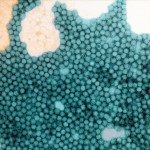Link to Pubmed [PMID] – 6084607
Dev. Biol. Stand. 1984;57:165-70
Monoclonal antibodies were used in previous work to define neutralization epitopes (NE) of poliovirus during its natural variation upon interhuman passages. Two kind of NE were found: constant (K) epitopes, present on practically all poliovirus strains of the same serotype, and variable (V) epitopes, which were strain-specific either for wild-laboratory strains (Mahoney, MEF1, and Saukett) (VW epitopes), or for attenuated Sabin strains (VS epitopes), or for attenuated Sabin strains (VS epitopes). In the present paper we analyzed the NE formulae of poliovirus strains of each of the three serotypes isolated from paralytic cases that have occurred after mass vaccination with oral poliovaccine (Sabin). Type 1 isolates from both the central nervous system and stools showed the existence of the four VW epitopes characteristic for Mahoney virus. However, in some cases, variation of the K epitope formula was noticed. As concerns the paralytic cases where type 2 poliovirus was isolated, the situation was more complex due to the existence of three different VS epitopes. Various patterns of VS epitopes were encountered, making difficult the definition of the strains origin. Most of the type 3 strains isolated from paralytic cases contained one or both VS epitopes, some of them having an identical NE formula to the Sabin type 3 vaccine virus. These data showed that the use of strain-specific neutralizing monoclonal antibodies for the characterization of strain origin is more complex than generally agreed. The multitude of NE coexisting on the same virus particle and their variation during viral replication in the human intestine call for cautious interpretation of the results obtained in poliovirus intratypic differentiation by neutralizing monoclonal antibodies.

